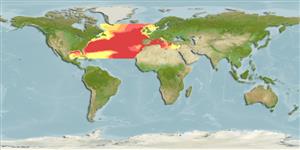>
Myctophiformes (Lanternfishes) >
Myctophidae (Lanternfishes) > Diaphinae
Etymology: Diaphus: Greek, dis, dia = through + Greek, physa, phyo = to beget, to have as offspring (Ref. 45335).
Eponymy: Professor Constantine Samuel Rafinesque-Schmaltz (1783–1840) was born in Constantinople to a French father and German mother. [...] (Ref. 128868), visit book page.
Environment: milieu / climate zone / depth range / distribution range
Ecologia
marino batipelagico; oceanodromo (Ref. 51243); distribuzione batimetrica 40 - 2173 m (Ref. 104125). Deep-water; 62°N - 20°N (Ref. 4479)
Eastern Atlantic: British Isles to Mauritania including the Mediterranean and Iceland (Ref. 12462). Western Atlantic: north of the Gulf Stream. Northwest Atlantic: Canada (Ref. 5951). Also reported from the Indian and the Pacific Oceans (Ref. 26165).
Length at first maturity / Size / Peso / Age
Maturity: Lm 5.8 range ? - ? cm
Max length : 9.4 cm TL maschio/sesso non determinato; (Ref. 128245)
High-oceanic, found between 325-750 m during daytime (Ref. 4479). At night, a two layer system occurs, with adults found at 300-600 m and juveniles at 40-200 m (Ref. 4479).
Life cycle and mating behavior
Maturità | Riproduzione | Deposizione | Uova | Fecundity | Larve
Hulley, P.A., 1990. Myctophidae. p. 398-467. In J.C. Quero, J.C. Hureau, C. Karrer, A. Post and L. Saldanha (eds.) Check-list of the fishes of the eastern tropical Atlantic (CLOFETA). JNICT, Lisbon; SEI; Paris; and UNESCO, Paris. Vol. 1. (Ref. 4479)
IUCN Red List Status (Ref. 130435: Version 2024-1)
Threat to humans
Harmless
Human uses
Strumenti
Special reports
Download XML
Fonti Internet
Estimates based on models
Preferred temperature (Ref.
123201): 5.2 - 14.2, mean 10.8 °C (based on 401 cells).
Phylogenetic diversity index (Ref.
82804): PD
50 = 0.5000 [Uniqueness, from 0.5 = low to 2.0 = high].
Bayesian length-weight: a=0.00977 (0.00483 - 0.01976), b=3.15 (2.98 - 3.32), in cm total length, based on LWR estimates for this species & Genus-body shape (Ref.
93245).
Trophic level (Ref.
69278): 3.4 ±0.45 se; based on food items.
Resilienza (Ref.
120179): Alto, tempo minimo di raddoppiamento della popolazione meno di 15 mesi (Preliminary K or Fecundity.).
Fishing Vulnerability (Ref.
59153): Low vulnerability (10 of 100).
Nutrients (Ref.
124155): Calcium = 104 [29, 289] mg/100g; Iron = 0.553 [0.203, 1.737] mg/100g; Protein = 16.5 [14.7, 18.3] %; Omega3 = 0.501 [0.186, 1.343] g/100g; Selenium = 14.9 [4.5, 48.0] μg/100g; VitaminA = 87.7 [10.6, 710.1] μg/100g; Zinc = 0.8 [0.4, 1.7] mg/100g (wet weight);
